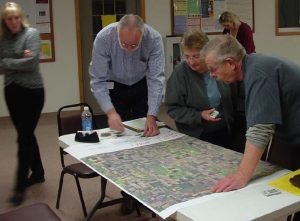Steps in a Planning Process
Stage 1: Pre-Planning
The first, and in some respects, the most important stage is ‘pre-planning,’ or preparing to plan. This stage consists of two steps: diagnosing the community and designing the planning process. Once local officials and the public understand the purpose, values and benefits of planning and agree on a process to prepare the plan, the following steps become much easier.
Community Diagnosis
- Determine your community’s purpose, capacity and readiness for planning.
- Inventory existing plans, studies and tools.
- Explore preliminary issues and concerns.
- Identify potential planning participants and stakeholders.
- Build capacity for planning by providing education to local officials and residents.
Process Design
- Establish a budget for planning.
- Determine who will prepare the plan.
- Issue a request for proposals if you will be working with a consultant.
- Establish roles, responsibilities and membership of groups involved in planning.
- Identify preferred steps in the planning process and desired end products.
- Incorporate opportunities for public participation and education.
Stage 2: Planning

The second stage, ‘planning’ consists of five major steps. These include: data collection and analysis; issue identification; formulating goals and objectives; selecting policies and tools; and formally adopting the plan. The planning diagram on this page shows several positive feedback loops. This is meant to illustrate that planning does not always proceed in a linear fashion. At times, your community may need to revisit or reorder steps to respond to new data or unexpected reactions to a proposal. Some flexibility should be built into the process to accommodate these unknowns. Depending on how you choose to organize the planning process, your community may also have more or less steps than what is shown. For example, many communities include a ‘visioning’ step. Others consider visioning a public participation technique and use it early on as a means to kick off the process. Public participation is shown at the center of this diagram to illustrate that the public should be included throughout the planning process. Chapter 4 provides additional detail on designing the public participation process.
Data Collection and Analysis
- Assess your community’s data and information needs.
Gather technical and spatial data from county, regional, state and federal sources.
Gather public opinion data through surveys, focus groups or other means.
Analyze and interpret data, making future projections where necessary.
Present patterns and trends to local decision-makers and the public.
Issue Identification
- Involve local decision-makers and the public in identifying key community issues, challenges, opportunities and desires.
- Use local data and analyses to support or identify additional issues.
- Prioritize issues to be addressed in the plan.
- Identify a vision for the future development of the community.
Goal and Objective Formulation
- Develop goals and measurable objectives to help attain your community’s vision.
- Develop indicators to monitor progress towards reaching goals and objectives.
Strategy Formulation
- Identify potential plan implementation strategies to satisfy goals and objectives.
- Evaluate impacts of alternative strategies and select preferred options.
- Recommend specific plan implementation policies, programs, actions and tools.
- Describe timeline and parties responsible for plan implementation.
- Plan Review and Approval
- Present the plan for community residents and officials to review.
- Make changes to the plan to resolve inconsistencies or address issues of concern to local officials and the public.
- Take formal action to adopt the plan.
Stage 3: Post-Planning
The third stage, ‘post-planning’ consists of plan implementation, monitoring and evaluation. These topics are discussed in additional detail in Chapter 5. Options for updating the plan are provided at the end of this chapter.
Plan Implementation
- Adopt a specific course of action to implement the plan.
- Develop or amend local policies, programs and tools as recommended in the plan.
Monitoring and Assessment
- Monitor progress towards achieving stated goals, objectives and indicators.
- Review and revise plan according to schedule stated in the plan or in response to changing community needs.





